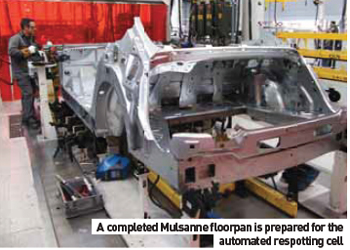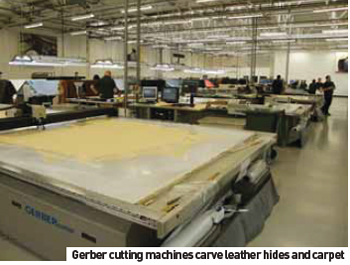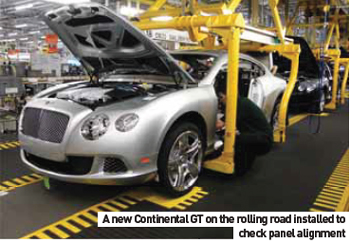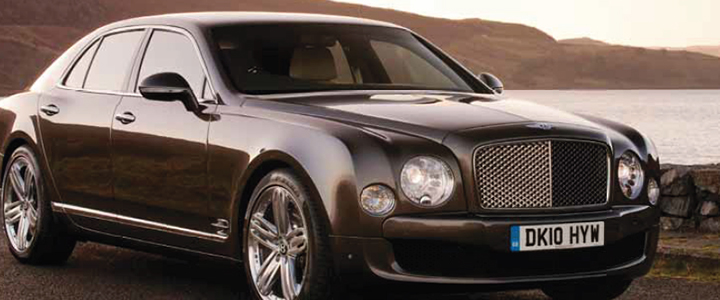The Bentley factory has seen changes for production of the new Mulsanne, plus various updates to the existing Continental line
In 2002, Dave Hudson, then Senior Production Manager at Bentley Motors, was part of the team that designed and implemented the production processes that would ultimately deliver the current range of Continental models. Fast forward to 2010 and Hudson, now Bentley’s Production Director and the top man on the factory floor, was tasked with implementing the same efficiencies put in place across Continental production on the line that would be building the new Mulsanne saloon. To date, the result is a series of spacious, brightly-lit halls where the various activities have been organised to promote ease of production and improved lineside part delivery.
This logical process flow is the driving principal behind the layout of the new bodyshop. Relocated into what used to be a parts and accessories warehouse, the newly-extended building features what Hudson describes as a ‘mix of old and new technology’. Body panels (which are largely delivered from Salzgitter AG, Germany, with door inners and front fenders supplied by Superform, based in the UK) are stored in vertical stillages in order to save floor space. The position of each storage unit is dictated by what subassembly it will be used to create and the flow behind that process. “The system is based on local kitting and the reduced inventory being delivered to the lines,” he says. “It’s a direct feed system, the place where the parts are kitted is next to where the parts are used. There is very little buffering.”
The latest model to enter production at Bentley is the Mulsanne saloon, the body of each formed using about 600 individual parts. In the bodyshop, single parts are welded into smaller subcomponents before these are brought together to create completed subassemblies, although there are a few exceptions: “The wheel well and the fender are separate parts due to the length. It’s the most cost-effective way for us to do it,” says Hudson. Subassemblies are completed as close as possible to the central spine – the BIW line – and delivered just-in-sequence for application to the chassis. While the system may be new, some of the jigs used to position the various subassemblies were brought in from the old bodyshop and adapted for use with the Mulsanne.
Gary Picken, Senior Production Manager for BIW, says that one of the priorities with the Mulsanne was to create a stiffer, lighter body than that of the out-going Arnage saloon.
To do this, the new model uses a variety of steels; sills are made from ultra-high strength steel, while B-pillars are formed using B20-grade product, stronger than that used in the Arnage or Continental. The results are impressive; compared to the Arnage, roof crush performance has been improved by 200%; side pole crash is 24% better; front-end crash has been improved by 36%; and side barrier is 32% better.
To help reduce overall vehicle weight, the Mulsanne uses aluminium doors and bonnets. These are fabricated in an a two-stage aluminium flex cell, where three types of rivets (depending on the thickness of the material) and adhesive are used to join door inners and outers. Once the aluminium parts are joined, they advance into an automated roller hemming cell that features Comau robots. “Comau delivered the facility as a turnkey project. We had to decide whether to go with Kuka, as [Volkswagen] group standard, or Comau.
The technical side is that this robot has all the structure and wiring inside the unit, the others were outside. If you’ve got a tight cell like this, it’s easier to setup when the cables are inside the robot.”
The completed BIW for the Mulsanne has approximately 5,800 spotwelds. In addition, each car uses 127m of structural adhesive and 24m of anti-flutter (insulation), typically applied between the door panels. Further, each car uses 28m of MAG welding and approximately 1.8m of hand brazing is used on the A- and D-pillars and the rear saddle.
In the first station, the floor panel is married to the longitudinals and bulkhead subassemblies, after which the sills and full bulkhead are added. At this point the car is defined as left- and right-hand drive and given an identifying number. In the last underbody station, turnover jigs are used to roll the completed subassembly upside-down in order to complete further welds – quite a feat for a car that is almost five metres long.
Once these joins have been completed, a transfer skid delivers the car to the first robot station for respotting. In the same station, a second robot applies more than 150 fixing studs in a two-pass operation. The bodysides, which are fabricated in stations on either side of the main line, are then lifted over and positioned in gates for marriage to the roof.
The completed assembly is then lifted so the underside can be positioned in preparation for preliminary tabbing before a first body geometry check is completed.
 The hand-brazed welds on the Mulsanne BIW require meticulous finishing, which is carried out by a team of associates that follow each body through four stations. Dave Hudson says that the finishing process, which takes about twenty minutes per join, involves removing the top layer of brass before filing the seam. To achieve the final finish, the weld seam is tapped up from behind the body panel.
The hand-brazed welds on the Mulsanne BIW require meticulous finishing, which is carried out by a team of associates that follow each body through four stations. Dave Hudson says that the finishing process, which takes about twenty minutes per join, involves removing the top layer of brass before filing the seam. To achieve the final finish, the weld seam is tapped up from behind the body panel.
Hudson: “As you tap it up from underneath and file the surface, it starts to highlight where the low spots are in the joint. The goal is to highlight where next to lift the panel. Once its been tapped up, we can achieve a perfect shape on the outside. The panel’s 0.8mm thick. When it’s finished, it’ll be between 0.55 and 0.6mm, a result of polishing the surface to highlight irregular shapes when we file.
“If you look at a finished brazed joint, it’s artwork. There’s an incredible level of skill that goes into completing these joins. What you try to achieve is a joint that nobody can see, that makes the panel look like it’s made from solid metal.”
The attention to detail extends to other areas of the car, notably the seam between the rear fender and the return flange of the wheel arch. “This is closed using a purely cosmetic soldering operation,” says Picken. “When it’s painted you don’t see any gap.” Why is this necessary, as the seam is located behind the door and invisible unless the door is open? “We don’t want the customer to see the gap when they open the door. We want them to see a smooth panel. We have to achieve this level of detail as it’s what our customers expect.”
 The exterior dimensions of each Mulsanne body are tested using CMM equipment supplied by Wenzel. Individual welds are checked using ultrasonic equipment. “Weld testing is carried out over a set cycle,” says Hudson. “Within a week we test every spotweld in the car. Because it takes a week and a half to produce a body, we can capture all the spotwelds in the bodyshop and if there’s a failure – which is quite rare - we can chase it backwards, rather than forwards, through the system.”
The exterior dimensions of each Mulsanne body are tested using CMM equipment supplied by Wenzel. Individual welds are checked using ultrasonic equipment. “Weld testing is carried out over a set cycle,” says Hudson. “Within a week we test every spotweld in the car. Because it takes a week and a half to produce a body, we can capture all the spotwelds in the bodyshop and if there’s a failure – which is quite rare - we can chase it backwards, rather than forwards, through the system.”
Off to the side of the new bodyshop is an area dedicated to teardown testing, a process which used to be carried out by an external company at a cost of £30,000 ($45,000) per body. Now, four times each year, a completed body is taken off the line and deconstructed in order to test the integrity of each weld. “It takes about a week to teardown a car, but the pile of scrap outside means that we have records. Doing this costs less, validates our ultrasonic testing and we get a quicker response for improved quality,” says Hudson Eddie Latimer, Body and Weld engineer, explains how the testing is carried out. “[Weld integrity] is based on the nugget size and diameter. The diameter should be four times the root thickness of the thinnest sheet. We check that with the Vernier [callipers] to make sure it’s within that standard.
Measuring that shows how much torsional strength you’ll get per weld. Good welds leave the nugget on the parent material, while the other piece tears away.”
Latimer goes on to say that the total number of welds is evenly split between those completed by robots and by hand.
“The manual welds compliment what the robots are doing,” he reports. Is Bentley planning to increase the amount of automated welding? “We’re achieving a very high pass rate for welding,” says Dave Hudson. “A couple of minors dotted around the car wouldn’t cause us any great concern because of the number of welds and the amount of structural adhesive. If we look to additional automation, it has to be cost-effective and give us a real benefit. Will we use the same techniques as a mass manufacturer? Probably not. We have to use the skill levels and facilities we have to get as close to perfection as possible.”
Like the bodyshop, the seating and trim department has been relocated to a dedicated area large enough to accommodate all related production processes in close proximity, creating what Dave Hudson refers to as ‘a centre of excellence’. “When we expanded, we wanted to open this area out, make more of it. Together with body and wood, seating is one of Bentley’s core competencies. We want to be known for high quality, high complexity and low volume manufacturing with a lean platform.”
 The Trim Development Centre is the first department in the new seating and trim area, where designers and engineers construct prototypes for interior components and assemblies. This office leads out onto a production floor populated with various Gerber cutting machines, different versions of which are used to cut the leather hides and carpeting. Unlike the previous location of the seating and trim centre –between the Continental and Arnage production lines – the space is bright and open, with each successive operation arranged in a well-ordered progression. The logistics centre delivers leather hides and seat frames where and when they’re required across the department.
The Trim Development Centre is the first department in the new seating and trim area, where designers and engineers construct prototypes for interior components and assemblies. This office leads out onto a production floor populated with various Gerber cutting machines, different versions of which are used to cut the leather hides and carpeting. Unlike the previous location of the seating and trim centre –between the Continental and Arnage production lines – the space is bright and open, with each successive operation arranged in a well-ordered progression. The logistics centre delivers leather hides and seat frames where and when they’re required across the department.
Sixteen hides are needed to produce the interior of the Mulsanne, while 14 are used in the Continental GT; hides are stacked onto horses for delivery to the cutting area. As an example of reduced buffering, only nine horses can be loaded at any one time.
What has not changed in the attention to detail, particularly with regards to grading the leather. Hudson: “New associates go on a training course where they learn how to inspect, grade and cut the leather. Each week the team leader will take a marked up hide and reinspect it to make sure the associates are staying within about a 95% pass rate.”
Carpets are cut using Gerber GTXL machines, which automatically nest patterns to efficiently cut the required shapes. As a man-made product, Hudson says carpet is easier to work with than hide, but cut accuracy is still important. “Carpeting goes directly to the production line. If it’s 5mm short in an exposed area, it’s very easy to see. Attention to detail and cut accuracy are vital.”
The sewing area, which produces parts for both the Mulsanne and Continental ranges, is located next to the Gerbers. “The sewing is completed in kitted sets, you can see the build manifest for each car, with all the options – including leather quilting and new, soft-touch trim parts. Once the parts are completed, they’re packed into a box and sequenced to the line; the complexity here is absolutely massive.”
All seat variants, both front and rear, are produced in the same area before being forwarded for ‘finessing’, which checks the electrics, components (DVD headrests, etc.) and force resistance of the seat adjustment controls. Seats are then passed through for final quality checks before being bought off and delivered to the line. According to Hudson, a single driver delivers seats in sequence to the line. Buffered stock is kept to a maximum of two hours production time, enough for two cars.
“Across the seating and trim department, the feedback, the involvement, they’re both very strong,” he says. “The close interaction between stages is what makes a centre of excellence.”
In order to support the increased component content of the new Continental GT, a wider, U-shaped turn has been added to the top of the model’s dedicated assembly line. In addition to creating space for eight new stations on the Continental line, the reduced storage and buffering has created sufficient space for five new stations on the adjacent Mulsanne line.
 Hudson says that this has had a two-fold effect, with the changes improving access for lineside part deliveries, while also helping to reduce process density. “We previously had about 3.5 people per station and that’s been reduced to about 2.5 people. What you get is less process interference and improved efficiency.
Hudson says that this has had a two-fold effect, with the changes improving access for lineside part deliveries, while also helping to reduce process density. “We previously had about 3.5 people per station and that’s been reduced to about 2.5 people. What you get is less process interference and improved efficiency.
“When you put more people on a station, the interference they create is huge – and this is where you can get quality issues. If one process is late, the next is delayed. There’s a huge benefit to improving (station) density. I would like to be at about 1 – 1.5, particularly as volumes are about to increase.” This, Hudson explains, will see takt times reduced from 93 to 82 minutes per station on the Mulsanne lines. How will potential savings be identified? “By managers, team leaders and associates working together. Every process will have to find new efficiencies,” he explains.
Another change to both the Continental and Mulsanne assembly lines is the addition of on-line body profiling.
“Instead of pushing quality down the line and reworking off-line, we brought the profile teams onto the line,” says Hudson. In the case of the 624 Continental, the cars were first set on their wheels as they came off the assembly line. Now, in order to check panel alignment, a short conveyor has been installed on the line. Travelling at the same speed as the overhead carriers, the body is set down so the panel alignment can be checked, helping to reduce or eliminate any body rework.
The underlying reason for adding the conveyor is that Continental models have the front fenders removed in order to add headlights and other electrical equipment. As the 831 Mulsanne does not have its fenders removed there is no need for the same conveyor setup, but the car has other parts that can complicate panel profiling. “On most cars the bonnet and boot lid go right up to the windscreen,” says Hudson. “On the Mulsanne, there is a scuttle panel between the closures and the pillars, running between the fenders.
Small changes might have taken place in the paintshop, so we check the gaps using a measurement wheel and a Vernier in order to make fine adjustments, which helps when fitting parts later on. The beauty of doing checks here is that we have the whole line to put it right instead of waiting until the end.”
Various key assemblies for the Mulsanne are built up next to the line. One of these is the dashboard, which incorporates soft-touch components subassembled in the trim zone and delivered to a dedicated buffer in preparation for unit assembly. As Hudson explains, the dashboard production is based on a direct-feed system with essentially no buffer.
“The lead time for the dashboard, from when it’s finished to when it’s put in the car, is two hours. If we get a problem with the dash, it immediately affects the line, but this has been done on purpose. Having smaller buffers makes you react more quickly to the problem. Bigger buffers mean a slower response.”
Like the dashboards, doors are also kitted next to the line, the painted assemblies residing on custom-made dollies in preparation for the addition of electronic components, brightware and more soft-touch inserts.
The Engine Shop has also been relocated closer to the assembly line marriage stations to further improve component flow. The W12 operation is controlled with extensive use of DC tools. Final testing involves leak down, with further cold and hot tests.
The twin-turbo V8 engine used in the Mulsanne is built in same shop, but the comparatively small operation features a high level of manual intervention. “All these engines are put on our prebalancer to check [engine] alignment before completing the full hot test. The buffers between areas are very small.”
Asked if there are any changes that could be made to improve lineside engine delivery, Hudson implies that it is a job well done. “This is about as good as it gets. There will be elements that we can ask logistics to address, or we can ask suppliers to perform some subassemblies, but every time we do this, we are more competitive [in terms of price].”
As a part of the Volkswagen Group, it could be expected that Bentley Motors is obligated to use shared components and the same equipment suppliers as other VW Group companies. But as the installation of a new Comau-supplied roller hemming cell shows, the luxury carmaker is not obliged to follow the group standard.

Speaking to Dave Hudson, Production Director at Bentley, AMS asked what – if any – influence Volkswagen Group had on production of the Mulsanne and Continental models. “We carry over some architectural things from areas of the group, but it’s a Bentley and it has to be seen as a Bentley. The things we’ve had from group are synergy elements, electricals, chassis. Essentially we maintain a policy of ‘carry over modified’, meaning that we bring parts over and adapt them to suit Bentley dynamics. In real terms, this means that not a lot of the car is group-related.”
Last updated in 1989, the paintshop will be the next area to be upgraded. As the project was only recently sent out to tender, it is as yet unclear which company will be delivering the new facility. What is certain, though, is that painting a Bentley will remain a largely manual process, complemented with the addition of robotics in various support roles.
“The skill level in the paintshop is incredible. We want to look at the paint and application methods, but some areas will always be done by hand and others can be done using a robotic spray.”
Another reason to update the paintshop is the tightening of related regulations. “The environment is important, outside and inside the shop. As a company, we must respond to the environment, cutting VOCs and waste. But there’s also the environment within the shop. It’s not always about the product, it’s about lifting the people. How people feel about where they work has a direct influence on what the customer gets in terms of quality.”
Was quality affected by launching two new models in quick succession? “What really complicates matters is launching the new cars while still doing the limited editions and updates on the existing models. We’ve introduced the Mulsanne and the Continental GT, but we’re still producing the saloon version of the Continental GT and the Coupe, which have both undergone some significant changes.”
This, says Hudson, is purely market-driven – as was the decision to continue with development of the Mulsanne.
“Every company struggled during the downturn, but you have to come out the other side with new product. We could have stopped the [Mulsanne] project, but with the high level of investment continuing was the right thing to do. New products generate interest and you need to have that when the fog lifts, and it is lifting.
“We’ve invested in body, seats, engine and assembly. Paint is the last piece of the jigsaw. After that’s done we’ll start again, because we’ll be looking to improve processes for the next car – that will dictate where to do facility updates.”
































